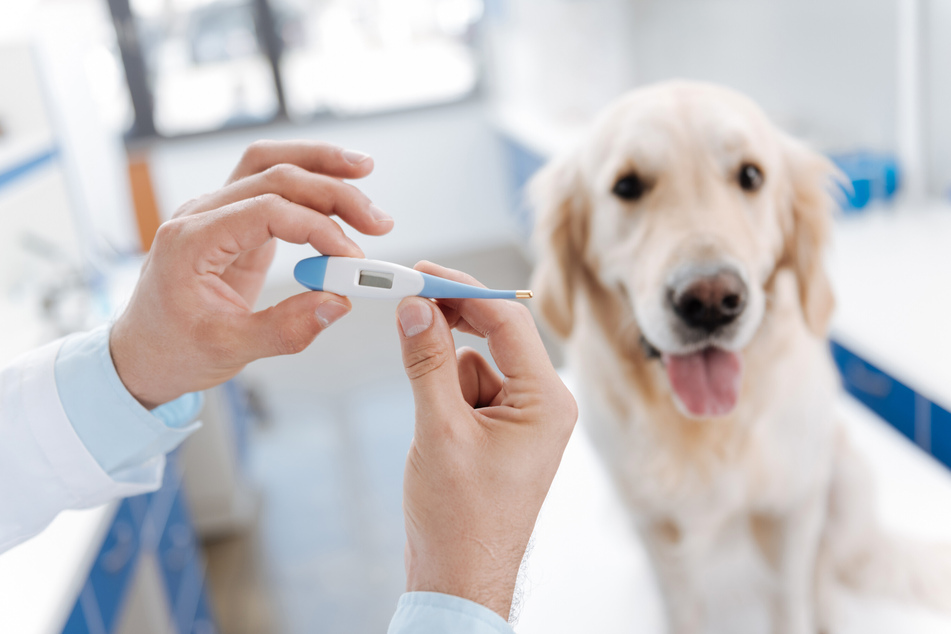Dog fever symptoms and treatment: How to tell if a dog has a fever
Have you ever wondered why the body temperature of a dog is higher than a human? What constitutes a fever in a dog, how can you treat it, and what are the typical symptoms to look out for?

When a dog pants, it can be seen as a sign of overheating, and a way to cool down its body.
In the case of a fever, though, its panting could indicate something far worse and far more dangerous. Indeed, in much the same way that a human fever can mean trouble, fevers in dogs can be deadly.
So, how do you tell if your dog has a fever, what is its typical temperature, and when do things get dangerous? Discover the usual symptoms of dog fevers, and how to treat your sick puppy, in this dog guide.
How to tell if a dog has a fever
While dogs do have a higher average body temperature than humans, it is still possible for their bodies to overheat and cause serious health issues. This especially goes when a fever is brought on by a virus, or some other illness, as fevers can be a sign of severe infection.
In general, a dog's body will operate between 99°F and 103°F, putting them a solid few degrees above what humans operate at. Just like humans, though, these temperatures change throughout the day, with a dog being the coolest in the morning and gradually hotter as the day progresses.
Environmental factors are also important, as dogs that are experiencing hot weather will typically measure higher in body temperature. This is important as dogs can also experience heat stroke (from body temperatures about 104°F) and hypothermia (from body temperatures below 98°F).
Here is the standard range of dog body temperatures:
- Below 98°F: Lower body temperature than normal, seek medical attention if sustained or significantly lower than this value.
- Between 99°F and 103°F: Normal body temperature, resume normal behavior.
- Between 104°F and 105°F: Elevated temperature, likely due to exercise or excitement
- From 105°F: Fever.
- From 106°F: High fever, minor risk to life.
- From 107°F: Extreme fever, high risk to life, and severe risk of organ failure.
You should take your dog to a veterinarian as soon as it reaches 105°F or above. It is not worth observing and waiting, and better to get your doggo checked out immediately.
How to take a dog's temperature
Taking a dog's temperature isn't as easy as it may look. After all, your canine companion has no idea what's going on, and may not react kindly to a metal rod up the booty. As a result, we'd recommend having two people help to complete this task, one comforting the doggo while the other does the temperature taking.
Here are our step-by-step instructions for taking a dog's temperature:
Step 1: Moisten the tip of the thermometer with Vaseline.
Step 2: Lift your dog's tail.
Step 3: While your partner is reassuring and keeping the dog calm, insert the thermometer slowly and carefully into the depths of your pup's anus, about an inch.
Step 4: Hold the thermometer firmly, while speaking reassuringly to your doggo and keeping it still.
Step 5: Wait for the duration of the measurement, which will usually indicate to have finished when the thermometer beeps.
Step 6: Check the measured temperature and respond accordingly.
After taking your dog's temperature, it is worth rewarding it with a treat and some fun time.

How to tell if a dog has a fever without a thermometer
As your doggo gets increasingly hot on account of illness and fever, you will likely be able to tell even without the use of a thermometer. In particular, look out for increased sweat secretion as well as increased panting. The problem with dogs is that they do not have the same system of sweat and evaporative cooling as we humans do, making them much less efficient at regulating heat.
Dogs that are hot or feverish will stick out their tongues, pant, and breath very shallowly through the nose. If this is occurring in cold weather, or in a situation where heat cannot explain their behavior, they could have a fever. Look out for the other symptoms of fever (explained below) and react accordingly. Always bring your dog to a vet when in doubt.
Dog fever symptoms

Heat regulation is not the only way that a dog's body will react to a fever, as it can be brought on by a viral or bacterial infection of one kind or another. Additionally, injuries and wounds can cause a fever, as the dog's immune system fights to repair its body or expel an invader.
There are a number of other dog fever symptoms worth mentioning and looking out for. Here are a few to keep an eye on:
- Chills/shivering
- Listlessness, tiredness
- Increased heart rate
- Very hot ears
- Severe panting
- Refusal to eat food or drink water
- Diarrhea
- Red or glassy eyes
- Runny nose and other cold symptoms
- Coughing
- Vomiting
Important: If you notice the symptoms of fever, or suspect a fever for whatever reason, your vet should be consulted as soon as possible. Go for professional medical attention if you're worried.
Dog fever treatment at home
We here at TAG24 are not doggy doctors. If your perfect pooch has a fever, it is important to determine its temperature and establish whether it is simply overheating from a hot day (and therefore needs to cool down) or actually has a fever.
If the latter is true, and your dog has a fever, it's time to take action. That action, however, is simply to take your dog to the veterinarian, get it professionally treated, and follow the instructions that your vet gives you.

If your dog has a fever, it should be treated seriously
When a dog has a temperature above 104°F, it is at risk of serious illness and should be treated with the respect and attention that you would give to a child. While doggos run hotter than we humans do, they are not meant to be burning like an oven, and such a symptom can directly correspond to serious illness, and can even cause harm in itself.
Don't try to diagnose the illness yourself, and don't try to utilize some kind of random home remedy to bring its temperature down. Instead, put on the leash or carrier, and go straight to the veterinarian for help.
Cover photo: 123RF/yacobchuk



